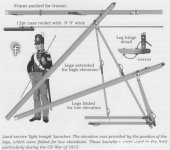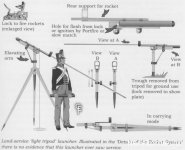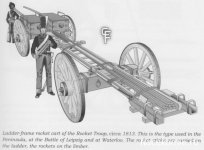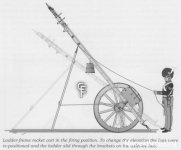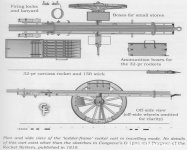And the rockets' red glare,
The bombs bursting in air...
I know, right? Considering how many times I've heard the US Anthem lyrics, it's pretty embarrassing that it took me that long to connect a few dots. Yet, it was right there, in my face. The poem was written in 1814. The date motivated me to see what this "red rocket glare" was all about. "Bombs bursting in air" also sounded important. They were exploding specifically "in air".The bombs bursting in air...
Figured that in our research serious attention to details like that is important. So, we have two things to look at.
- Red glare of the rockets.
- Bombs exploding in the air.
Show Biz
When was the last time you've seen a rocket being launched in a movie about the United States Civil War of 1861-65, or in any of the year 1812 related movie? I do not recall ever seeing one. At the same time, I do remember cannons, cannonballs and muzzle-loading rifles. The point here is that the below info is not hidden at all. At the same time the sources forming our general education choose to omit certain facts. Let's see whether we can shed some light on those omitted facts.The Star-Spangled Banner
"The Star-Spangled Banner" is the national anthem of the United States. The lyrics come from the Defence of Fort M'Henry, a poem written on September 14, 1814, by the then 35-year-old lawyer and amateur poet Francis Scott Key after witnessing the bombardment of Fort McHenry by British ships of the Royal Navy in Baltimore Harbor during the Battle of Baltimore in the War of 1812. Key was inspired by the large U.S. flag, with 15 stars and 15 stripes, known as the Star-Spangled Banner, flying triumphantly above the fort during the U.S. victory.- On September 13 and 14, 1814 a 25-hour barrage of Congreve rockets was fired from the British ship Erebus against Fort McHenry in Baltimore. The Erebus carried about 20 Congreve rocket batteries consisting of a box housing multiple metal firing tubes. Each of the rockets fired against Fort McHenry weighed about 30 pounds, and carried an incendiary charge. Although a number of American ships were destroyed by Congreve rockets during the War of 1812, just four deaths and minimal damage was reported at Fort McHenry during the siege.
Orpheus
Orpheus etymology: A probable suggestion is that it is derived from a hypothetical root *h₃órbʰos "orphan, servant, slave" and ultimately the verb root *h₃erbʰ- "to change allegiance, status, ownership". Cognates could include Greek ὄρφνη (órphnē) "darkness", and surely Greek ὀρφανός (orphanós) "fatherless, orphan", from which comes English "orphan" by way of Latin.
TPTB is pretty consistent: When Jesus abandoned America, or why TPTB prefer Pagan Gods
Rocket History
Anyways, we should probably get back to our rockets. Let's go over a short summary of the narrative compliant rocket history. For the longer one you can click here.The first gunpowder-powered rockets evolved in medieval China under the Song dynasty by the 13th century. The Mongols adopted Chinese rocket technology and the invention spread via the Mongol invasions to the Middle East and to Europe in the mid-13th century.Internal-combustion rocket propulsion is mentioned in a reference to 1264, recording that the "ground-rat", a type of firework, had frightened the Empress-Mother Gongsheng at a feast held in her honor by her son the Emperor Lizong. Subsequently, rockets are included in the military treatise Huolongjing, also known as the Fire Drake Manual, written by the Chinese artillery officer Jiao Yu in the mid-14th century. This text mentions the first known multistage rocket, thought to have been used by the Chinese navy.
- Medieval and early modern rockets were used militarily as incendiary weapons in sieges. Between 1270 and 1280, Hasan al-Rammah wrote The Book of Military Horsemanship and Ingenious War Devices, which included 107 gunpowder recipes, 22 of them for rockets. In Europe, Konrad Kyeser described rockets in his military treatise Bellifortis around 1405.
1775-1871
...our time frame of interest...
- 1. The Mysorean rockets were the first successful iron-cased rockets, developed in the late 18th century in the Kingdom of Mysore.
- 2. The Congreve rocket was a British weapon designed and developed by Sir William Congreve in 1804.
- This rocket was based directly on the Mysorean rockets, used compressed powder and was fielded in the Napoleonic Wars.
- It was Congreve rockets that Francis Scott Key was referring to when he wrote of the "rockets' red glare" while held captive on a British ship that was laying siege to Fort McHenry in 1814.
- Together, the Mysorean and British innovations increased the effective range of military rockets from 100 to 2,000 yards.
- The first mathematical treatment of the dynamics of rocket propulsion is due to William Moore (1813).
- In 1815 Alexander Dmitrievich Zasyadko constructed rocket-launching platforms, which allowed rockets to be fired in salvos (6 rockets at a time), and gun-laying devices.
- 3. William Hale (via his rocket) in 1844 greatly increased the accuracy of rocket artillery.
- Edward Mounier Boxer further improved the Congreve rocket in 1865.
- 4. Civil War Bazookas
- 5. Lifesaving Rockets
- I do question everything related to the exact years, or time frames presented by the narrative. Unfortunately we do not have any other way (at the moment) to place events on the time scale.
1. Mysorean Rockets
Mysorean rockets were an Indian (east India) military weapon, the first iron-cased rockets successfully deployed for military use. The Mysorean army used the rockets effectively against the British East India Company during the 1780s and 1790s.Tipu Sultan wrote a military manual called Fathul Mujahidin in which 200 rocket men were assigned to each Mysorean cushoon (brigade). Mysore had 16 to 24 cushoons of infantry. The rocket men were trained to launch their rockets at an angle calculated from the diameter of the cylinder and the distance to the target. In addition, wheeled rocket launchers were used in war that were capable of launching five to ten rockets almost simultaneously.
- Mysore started to equip their army with rockets in the 1750s.
- Rockets could be of various sizes but usually consisted of a tube of soft hammered iron about 8 inches (20 cm) long and 1.5 to 3 in (3.8 to 7.6 cm) in diameter, closed at one end and strapped to a shaft of bamboo about 4 ft (1 m) long. The iron tube acted as a combustion chamber and contained well-packed black powder propellant. A rocket carrying about one pound (~500 gm) of powder could travel almost 1,000 yards (~900 m). In contrast, rockets in Europe could not take large chamber pressures, not being iron cased, and were consequently not capable of reaching such distances.
- Tipu also defined in the manual a multiple rocket launcher (much like a musical organ) that would launch up to 10 rockets. Some of the rockets had blades in the front of the bamboo guiding rods, while others were designed as incendiary rockets.
- Tippu Sultan, continued to develop and expand the use of rocket weapons, reportedly increasing the number of rocket troops from 1,200 to a corps of 5,000.
- In battles at Seringapatam in 1792 and 1799 these rockets were used with considerable effect against the British.
Battle of Pollilur
- Note: The army of the East India Company surrendered and suffered a high number of casualties. It was the worst loss the East India Company suffered on the subcontinent until Chillianwala (1849). Benoît de Boigne, a French officer in the service of 6th Regiment of Madras Native Infantry, wrote, "There is not in India an example of a similar defeat".
KD: It appears that rockets were rather effective tools of warfare in 1780. Now we need to factor in that rockets were used by the Kingdom of Mysore since at least 1750s.
At this point, we could probably ask ourselves what the East India Company was doing in India. Somehow Tartary comes to mind. Whether the British army was working on their "eradicate Tartary" campaign, remains to be determined. But here is what our Tipu Sultan allegedly looked like.
- Portrait of Tipu Sahib, later Tipu Sultan. 1780. Oil painting by John Zoffany (1733 – 1810).
- The body of Tippu Sultan is laid out and mourned by a woman and servants. Zoomable, and you can see other faces too.
- There are many other (more narrative-like) portraits out there. I have seen the same pattern with many other Tartarian leaders. In my opinion, the below portrait is the one to consider.
1807 Copenhagen: The bombardment included 300 Congreve Rockets, which caused fires. Due to the civilian evacuation, the normal firefighting arrangements were ineffective; over a thousand buildings were burned - Battle of Copenhagen
Different source says the following: 25000 rockets were fired at this event, resulting in a total burn-down of the city.
The Congreve rocket was a British military weapon designed and developed by Sir William Congreve in 1804, based directly on Mysorean rockets. The first demonstration of his solid fuel rockets was in September 1805. The rockets were used effectively during the Napoleonic Wars, the War of 1812, and the First Anglo-Burmese War of 1824–1826.
- Congreve began in 1804 by buying the best rockets on the London market, but found that their greatest range was only 600 yards. He knew that Indian kings and emperors had equipped their armies with rockets which would travel much farther than this. After spending ‘several hundred pounds’ of his own money on experiments, he was able to make a rocket that would travel 1,500 yards. He now ‘applied to Lord Chatham (the responsible minister in charge of the Ordnance Department) for permission to have some large rockets made at Woolwich’. Permission was granted and ‘several six-pounder rockets’ made ‘on principles I had previously ascertained’ achieved a range of ‘full two thousand yards’. By the spring of 1806, he was producing 32-pounder rockets ranging 3,000 yards.
By 1813, the rockets were made available in three classes:
- Heavy – being carcass/explosive rockets, 100 and 300 pounders; between five and six feet in length, with a stick length of 25-27 feet. These were considered too cumbersome to use effectively in the field.
- Medium – being from 42 to 24 pounders; two to four feet in length, with a stick length of 15-20 feet
- The 32-pounder was generally used for longer range bombardment
- Light – being from 18 to 6 pounders; 16-25 inches in length, with a stick length of 8-14 feet
- A 12–pounder case shot was generally used for support of infantry and cavalry, with an extreme range of some 2,000 yards
Important: One in three horse artillerymen carried a launching trough for ground firing.
- C.E. Franklin - British Rockets of the Napoleonic and Colonial Wars (no link)
In December 1815, Congreve demonstrated a new design of rocket that had the rocket stick screwing centrally into the base of the case. This remained in service from 1817 until 1867, when it was replaced by the Hale rocket which required no stick and used clockwise rotation to impart stability in flight.
- KD: Hale's rockets were used a bit earlier than 1867.
Here is a 100-Pounder, and it's not even the largest one. The propellant was gunpowder while the warhead contained combustible powder meant for the destruction of forts.
- Of course, the narrative is consistent: However, the 100-pounder and other larger calibers up to the 300-pounder, never became operational since they were expensive and difficult to make and transport.
- Conical warheads - incendiary
- Round or ogival warheads - explosive
KD: Based on what I have seen in the Google Ngram, there were multiple "Rocket Ships" and "Rocket Boats" employed during various wars of the 19th century. Apparently there is a ship considered to be the very first one to be outfitted with rockets. Personally, I do not believe that the below vessel was the first one, but this is how the story goes.
HMS Galgo
HMS Galgo was the mercantile Garland, which the British Admiralty bought in 1801. She had a brief career in the Channel before she was laid-up in ordinary. She was refitted as a rocket ship in 1809, the Royal Navy's (and almost certainly the world's) first, and served as such but without distinction in the unsuccessful Walcheren Campaign. She then was laid-up again before she was sold in 1814.- Congreve had Galgo fitted with 21 scuttles (angled tubes) on her between deck, firing out through broadside ports. To prevent the rockets's exhaust from entering the vessel he had the scuttles fitted with iron shutters.
- She missed the bombardment of Ramakins. On 13 August 1809, she was part of a squadron under Sir Home Riggs Popham that pushed up the West Scheld, but saw no action. This is the only mention of Galgo in dispatches from the campaign published in the London Gazette. Clearly, Galgo's part in the campaign was minimal, though she may have fired her rockets at the bombardment of Flushing. Still, she was among the myriad vessels listed as qualifying for the prize money from the campaign.
HMS Erebus
HMS Erebus was originally built as a Royal Navy fireship, but served as a sloop and was re-rated as such in March 1808. She served in the Baltic during the Gunboat and Anglo-Russian Wars, where in 1809 she was briefly converted to a fireship, and then served in the War of 1812. In 1814 she was converted to a rocket vessel to fire Congreve rockets. While serving off America, Erebus participated in the sack of Alexandria, Virginia, and launched the rockets that bombarded Fort McHenry in Baltimore on 13 September 1814. In March 1815, off Georgia, she fired the second-to-the-last-shot of the war. She was laid up in 1816 and sold for breaking up in 1819.- In April 1814 HMS Erebus was equipped with a battery of 32-pound Congreve rockets installed below the main deck, which fired through portholes or scuttles pierced in the ship's side. This was an improved version of the design that Congreve had first installed in HMS Galgo.
Well, these were a couple of the narrative supported rocket ships of the early 19th century. The other ones For example, in April 1809 William Congreve fitted schooner Whiting, and two armored cutters Nimrod, and King George with rockets. You can help yourself to additional ships using the below two links:
3. Hale Rockets
With Mr. Hale we have another "regular" story. Hale was born in Colchester, England in 1797. He was self-taught although his grandfather, the educator William Cole, is believed to have tutored him. By 1827 he had obtained his first patent; he also won a first class Gold Medal of the Royal Society of Arts in Paris for his paper on ship propulsion using an early form of jet propulsion.In 1844, Hale patented a new form of rotary rocket that improved on the earlier Congreve rocket design. Hale removed the guidestick from the design, instead vectoring part of the thrust through canted exhaust holes to provide rotation of the rocket, which improved its stability in flight. He also added tail fins.
- These rockets could weigh up to 60 pounds and were noted for their noise and glare on ignition.
- Hale rockets were first used by the United States Army in the Mexican-American War of 1846–1848.
- Hale rockets were enthusiastically adopted by the United States, and during the Mexican War in 1846 a volunteer brigade of rocketeers was pivotal in the surrender of Mexican forces at the Siege of Veracruz.
- Although the British Army experimented with Hale rockets during the Crimean War they did not officially adopt them until 1867.
- By the late nineteenth century, due to improvements in the power and range of conventional artillery, the use of military rockets declined.
- They were finally used on a small scale by both sides during the American Civil War.
- It was most extensively employed during the Federal bombardment of Charleston, South Carolina in 1864.
The design of the launcher was exceptionally elegant, immensely simple and practical, and without a single unnecessary component. The rocket was placed in the open breech and on the fuse igniting the propellant, it accelerated up the barrel, which was a simple, thin-walled tube, and into its trajectory. The spade was welded to the open end of the breech, thus closing it, and had two legs which were dug into the ground, while the forelegs (simple rods) were secured by locking screws, enabling the elevation to be adjusted quickly and without any fuss, while their junction above the barrel served as' a simple foresight. The only other item was a folding backsight.
- The whole concept was brilliant and far ahead of its time. Indeed, had one of the gunners thought to lift the tube on his shoulder and point it directly at the enemy the bazooka would have entered service in the 1860s instead of the 1940s.
4. Civil War Bazookas?
Would a Civil War bazooka surprise you? Don't worry, TPTB made sure that all bazookas were busy killing whales during the Civil War. yup, all them Civil War bazookas were fishing. Sounds like a bad joke, right?Well, considering the linked source, I thought so to, but the proof started multiplying:
- The California Whaling Rocket Harpoon, invented about 1827, protected the face of the whaler when he fired his weapon.
- In the 1860's Captain Thomas Welcome Roys invented a rocket harpoon, making a significant contribution to the development of the California whaling industry. In 1877, John Nelson Fletcher, a pyrotechnist, and a former Confederate soldier, Robert L. Suits, modified Roys's rocket, marketing it as the "California Whaling Rocket". The rocket was highly effective in killing whales.
- The above Roys link has some additional info. Now we move into 1850s.
- Danish naval officer Captain Otto C. Hammer and the Dutchman Captain C. J. Bottemanne also imitated Roys' rocket harpoon. Hammer formed the Danish Fishing Company, which operated from 1865 to 1871. Botteman formed the Netherlands Whaling Company, which operated from 1869 to 1872.
From here I had to turn to Google Ngram. It did not disappoint.
But when we switch the search string from "rocket harpoon" to "harpoon gun", we learn that it was invented in 1731. Essentially we can see that many different versions existed. Dates also vary. As far as the US Civil War is concerned we have: 1857, 1810 -28, etc.
KD: Essentially we have a launching station available since at least 1731, and we have rockets available since way before 1731. We have bazooka rocket harpoons since at least 1856. The only thing we do not have is the actual bazooka. Looks like it was developed between 1918 and 1942. Blame the shaped-charge for the delay, I guess.
New York Rocket Battalion
New York Rocket Battalion was an artillery battalion organized in the state of New York for service in the Union Army during the American Civil War. The battalion was organized at Albany, December 5, 1861. It served at and near Washington, D. C., from December 1861, and in North Carolina from May 1862 until February 11, 1863, when the battalion organization was discontinued.- During its months of service, the Rocket Battalion used eight breechloading cannon designed to fire Hale rockets. These were developed by Major Lions himself, and presented to President Lincoln shortly after the Battle of Bull Run in July 1861. They proved very unreliable during tests and in combat, so after the battalion was disbanded, each battery received regular M1857 12-pounder Napoleon's instead.
- New York Rocket Battalion - Wikipedia
- KD: I call BS on this. Hale rockets were an upgrade on Congreve rockets, and those, as we know, were capable of "burning down" entire cities.
5. Lifesaving Rockets
I think this is where all the other "omitted" military rockets could be hiding. May be these "lifesaving"rockets were used as such as well, but they look and function in line with all the other rockets we've seen do far.The "inventors" I ran into are below:
- Invented the 1865 "Boxer rocket", an early two-stage rocket, used for marine rescue line throwing.
- Trengrouse's Rocket
- Over 300 Rocket Houses were built around the UK coast, the first one at Tynemouth in 1865 and Newbiggin's in 1866.
- What a nice coastal defense system that would be.
Nitrogen or Azote?
This 1841 cutout suggests that they were experimenting with some explosives that were much more powerful than our regular gun powder. It would be naive to think that military would ignore stuff like that.The bombs bursting in air...
- Air burst may also refer to naturally occurring explosion of meteors in atmosphere, as happened for example in the Tunguska event and the Chelyabinsk meteor.
Additional Rocket Sources:
- The history of metal-cased military rockets - an investigation - Standing Well Back
- Congreve Rocket System | warof1812ct.org
- Sir William Congreve Archive
- Hale rocket
- 13th Through 16th Centuries
- Rockets in the Civil War
- Rockets and Missiles: The Life Story of a Technology
Food for Thought

Source
1696

Source
1783 Messina Earthquake

Source
What do we really know?
Rocket Pods vs. 16th Century Volley Gun

Source
1696
Source
1783 Messina Earthquake
Source
What do we really know?
Rocket Pods vs. 16th Century Volley Gun
KD: Hopefully we all learned something new today. I know I did. What are your thoughts on cannonballs, muzzle-loaders and urban fires? I think there is a lot of BS running around. Certain events come to mind. In addition to all of them 19th century and Book of Miracles comets, occurrences similar to:
Our history is bizarre...


